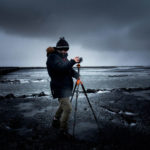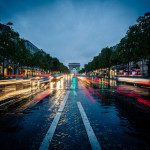If you’ve ever tried to take photos of your kids whilst they’re running about you will probably have experienced this. You wait ’till they are perfectly positioned in the frame, press the shutter, and end up with a shot of the back of their heads leaving the picture. That’s shutter lag and most digital cameras have it to some degree or another.

“Day 116. When Harry Met Sally” captured by Ata Mohammad Adnan (Click Image to See More From Ata Mohammad Adnan)
What causes shutter lag?
It’s caused by a few things but the main one has to do with the digital camera technology itself. The image recording chip inside the camera is actually producing a moving video picture all the time. This is what you see on the camera’s screen or viewfinder. When you press the shutter button you are actually capturing a “freeze frame” of this video.
This is why your camera manual might refer to the picture taking process as “image capture”. Whatever it’s called, the fact is that it takes quite a lot of processing and therefore can take a significant length of time. Digital cameras, like all digital devices, get more powerful with each generation so you should expect that a newer camera would have less shutter lag than an older one, but there is no guarantee of that.
What can you do about it?
There are three possible approaches to the problem of shutter lag. You can either eliminate it, minimise it or anticipate it. Of course, a fourth option would be to ignore it and, if you only ever take photographs of relatively static scenes, you will probably never even have noticed it. It’s only when you’re trying to capture a fleeting moment or a moving subject that you’ll find this to be a problem.
Eliminating shutter lag
There is only one sure-fire way to do this and that is by using a semi-professional or professional Dslr type camera. These cameras have an “old fashioned” mechanical shutter that has no lag. However because of that, you don’t get a “live” view in the back of the camera so you have to use the eyepiece just like you did with a film camera.
Minimizing shutter lag
The way digital cameras capture images is not the only reason for the delay, some of the settings on your camera can have a profound effect on the amount of lag. The worst culprit by far is an “anti-red eye” flash setting. This will fire your built in flashgun several times before taking the picture.
A friend of mine once took lots of pictures at a party with his new digital camera. He thought his camera was broken because, in all the pictures, he had managed to cut everyone’s head off. It only became clear what the problem was once I saw him take a picture.
Basically, he was doing everything right except that the anti-red eye system took ages to fire all the flashes and only the very last one actually takes the photograph. By the time that one fired, he was bringing the camera down and looking for the next group to photograph. Hence the cut off heads. Once he learned to wait for the very last flash to fire, his picture composition improved immensely.
A smaller, but still sometimes significant, delay can be caused by your camera setting the exposure and focus before it takes the picture. Both of these things are done with tiny motors moving parts of the lens about and this will always take a certain amount of time.
You can stop this happening in two ways. One is to set the exposure and focus manually on your camera. Not all cameras will allow you to do this and I suspect that not all that many people will want to “go manual” anyway, but all is not lost. You can usually still minimise the delay whilst leaving all the controls on fully automatic.
The double switch shutter button
Take your camera into a quiet room and very slowly press the shutter button. Before the button has reached the end of its travel you should hear (and possibly feel) the motors in the lens being activated. This is your camera setting its exposure and focussing before it takes the picture. Only when the button reaches the very end of its travel is the photograph actually taken.
The trick (or technique) is to press the button only half way down, and hold it there. Having done all the slow stuff in advance, pushing the button the rest of the way will take the photograph with the absolute minimum of shutter lag. This technique can also be used to “pre-focus”. For example, if you wanted to focus on something at the edge of the frame. You would centre on it, push the shutter half way then re-frame, press the shutter right down and take the picture.
Anticipating shutter lag
As you might expect, this will take a little time, effort and practice on your part but it could make the difference between taking a picture you would want to hang on your wall and one you want to instantly delete.
To find out how much lag your camera actually has you can try the following: Find a scene with a strong vertical line, like a lamp post or end of a wall etc. Pan your camera slowly through about 50 degrees so the line passes the edge of the frame. Do this a few times to get a consistent speed. It might help to slowly count as you are panning.
On one pass, press the shutter as soon as your marker line appears at the edge of your viewfinder – but keep panning, this is important. Your marker should appear in the middle of the frame. How far into the middle will depend on the amount of lag. Repeat this a few times and you should begin to get a feel for the amount of delay on your camera.
Now try anticipating the moment. Panning the camera the other way, try pressing the button when your marker gets to the point it was in the photograph you took and keep panning. This time, your marker should be right at the edge of the frame when the photograph is taken. If it is then you should now have a good sense of just how much shutter lag your camera has.
Keeping the spontaneity
Shutter lag is most annoying if you are trying to take candid, spontaneous photographs. That “perfect moment” is easily lost if you have to wait for the camera. One technique you can try is to start with your subject facing well away from the camera. Ask them to turn and face the camera when you call their name. The trick is to press the shutter as you call their name.
If they are still turning towards the camera when the picture is taken then just ask them not to look so far away from the camera at the start. Most people’s facial expression is much more natural if they are doing something at the time (like turning round) rather than just staring at a camera waiting for their picture to be taken.
If all else fails – cheat
Even if you have a feeling for the lag in your camera, it will still be tricky to capture precisely the perfect moment but there is one last thing you could try. It relies on your camera having a “multi-exposure” setting. However, many of them do. This setting will take several pictures one after the other as quickly as possible. So the technique is simply to take lots and lots of pictures.
This is a perfectly legitimate technique used by professionals all the time in fast moving situations. It’s just statistics really, if you take enough pictures then one of them is bound to come out “just right”. If it doesn’t then you simply haven’t taken enough pictures.
This used to be one of those things that separated amateur photographers from professionals because the cost of the film would hinder anyone not being paid for the work. Of course, in the digital world, this has all changed. Anyone can now virtually guarantee getting a good photograph whether their camera has any shutter lag or not.
About the Author:
Colin Aiken (www.lovethepictures.co.uk) is a professional photographer based in the United Kingdom.
Like This Article?
Don't Miss The Next One!
Join over 100,000 photographers of all experience levels who receive our free photography tips and articles to stay current:






I try to anticipate shutter lag and sometimes I time it out right, but it is still annoying. I am thinking it’s time to do some research on a DSLR. I had a 35mm Canon Rebel that I loved years ago, and I have not replaced it since moving into the digital era. I think it’s time!
Great article, thanks.
getting a bit academic with the new Olympus and Sony cameras…